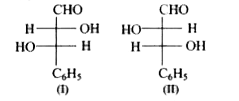What are enantiomers
The correct Answer is:C
Step-by-Step Text Solution:
1. Definition of Enantiomers: Enantiomers are a specific type of stereoisomer. They are defined as chemical isomers that are non-superimposable mirror images of each other. This means that if you were to place one enantiomer over the other, they would not align perfectly, much like how your left and right hands are mirror images but cannot be perfectly aligned on top of each other.
2. Characteristics of Enantiomers: Enantiomers have identical physical properties such as boiling point, melting point, and density, but they differ in their optical activity. This means that they rotate plane-polarized light in opposite directions; one enantiomer will rotate light to the right (dextrorotatory) and the other to the left (levorotatory).
3. Example of Enantiomers: A common example of a pair of enantiomers is lactic acid. There are two forms: dextrolactic acid (often referred to as D-lactic acid) and levolactic acid (L-lactic acid). The chemical structure of lactic acid can be represented as C3H6O3, and its two enantiomers have the same molecular formula but differ in the arrangement of atoms around a chiral center.
4. Visual Representation: To visualize enantiomers, one can draw the structure of lactic acid and its mirror image. The structural formula of dextrolactic acid can be represented as CH3-CHOH-COOH, while its mirror image, levolactic acid, would be the same formula but arranged differently around the chiral center.
5. Importance of Enantiomers: Enantiomers are significant in the field of pharmaceuticals because they can have very different biological activities. One enantiomer may be therapeutically beneficial, while the other may be inactive or even harmful.
Topper's Solved these Questions
- STEREOISOMERISMBOOK - RESONANCE ENGLISHCHAPTER - STEREOISOMERISMEXERCISE - EXERCISE (PART III : PRACTICE TEST-2 (IIT-JEE (ADVANCED PATTERN))
23 Videos
- STEREOISOMERISMBOOK - RESONANCE ENGLISHCHAPTER - STEREOISOMERISMEXERCISE - EXERCISE (ADDITIONAL PROBLEMS FOR SELF PRACTICE (APSP)) PART 1
30 Videos
- SOLUTIONSBOOK - RESONANCE ENGLISHCHAPTER - SOLUTIONSEXERCISE - Advabced Level Problems (PART-2)
35 Videos
- STRUCTURAL IDENTIFICATIONBOOK - RESONANCE ENGLISHCHAPTER - STRUCTURAL IDENTIFICATIONEXERCISE - Advanced level Problems (Part-III)
12 Videos
Similar Questions
Consider the following pairs of compounds :

Which among the following statements is correct?
1. Both are enantiomers
2. Both are in threo form
3. Both are diastereomers
4. Both are in erythro form
View SolutionWrite the appropriate structural formule for:
a. A cyclic molecule that is a consitutional isomer of cyclohexane
b. Molecules with the formula C6H12 that contain one ring and are enantiomers of each other.
c. Molecules with formula C6H12 that contian one ring and are diastereomers of each other.
d. Molecules with formula C6H12 that contain no ring and are enantiomers of each other.
e. Molecules with formula C6H12 that contain no ring and are diastereomers of each other.
View Solution
Knowledge Check
Identify the set of compounds which are enantiomers ?
A B
B C
C D
D
The separation of a racemic mixture into pure enantiomers is termed as :
ARacemizationBIsomerizationCResolutionDEquilibrationR, S-configuration is a useful tool for determination of enantiomers, diastereomers and homomers. If configuration of all chiral centers are opposite then structures are enantiomers, if all chiral centers have same configuration then they are homomers and if some have same configuration and some have opposite configuration then they are diastereomers.

Which of the following is not diastereomer?AI and IIIBII and IVCI and IVDIII and IV
Which of the following pairs are enantiomers?
View Solutionα−D−glucose and β−D−glucose are enantiomers. True/False
View SolutionThe specific rotation of a pure enantiomer is +16∘. The observed rotation, if it is isolated from a reaction with 25% racemisation and 75% inversion is
View SolutionThe specific rotation of a pure enantiomer is +10∘. The observed rotation, if it is isolated from a reaction with 30% recemisation and 70% inversion is
View SolutionR, S-configuration is a useful tool for determination of enantiomers, diastereomers and homomers. If configuration of all chiral centers are opposite then structures are enantiomers, if all chiral centers have same configuration then they are homomers and if some have same configuration and some have opposite configuration then they are diastereomers.

Which of the following is not diastereomer?
View Solution
